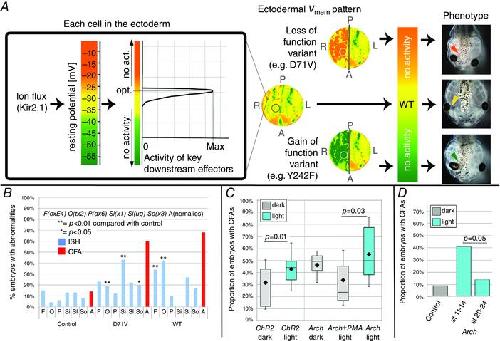XB-IMG-158797
Xenbase Image ID: 158797

|
|
Figure 8. CFA induction.
A, diagram illustrating our hypothesis about how either depolarizing or hyperpolarizing a cell membrane away from the optimal Vmem for the downstream effectors can lead to the same effect on phenotype. In every cell membrane, flux through ion channels, such as Kir2.1, or pumps sets the resting potential of the membrane. Vmem influences downstream effectors by affecting activity levels, in much the same way that temperature influences protein activity, and deviation from the optimum lowers activity. The example in this graph shows an effector that works optimally at a Vmem we have assigned the colour yellow, and drops off rapidly either above or below that value. The embryo-wide distribution of all of the cellsâ Vmem values (e.g. Fig. 6C) is the regionalization that we call the âelectric faceâ. To illustrate how gain- and loss-of-function variants, acting in a subset of individual cells, might disrupt the wild-type pattern and lead to dysmorphia, we have schematically represented changes to âVmemâ by using Photoshop to artificially change the colours that represent the different Vmem values. The three circular representations of embryos are pseudocoloured copies of the wild-type embryonic Vmem pattern shown in Fig. 6C. The first is the wild-type pattern. The upper illustration represents how inhibition of Kir2.1 on the right-hand side would result in depolarization of that side, as represented by orange, while the lower represents hyperpolarization (green) due to gain of Kir2.1 function. On each of the three schemes is a circle indicating the position of the cells that will form the area between the right eye and the brain. The lack of signalling by downstream effectors in these regions leads to abnormal morphology of the tadpole; the hyperpolarized and the depolarized conditions give rise to the same phenotype because both changes move the Vmem out of the range that permits protein activity. The micrographs at the far right side are photos of actual tadpoles that were treated as indicated: the top tadpole was injected with the loss-of-function variant D71V, the bottom with the gain-of-function variant Y242F. B, a comparison of the proportion of D71V and WT injected tadpoles with misexpressed patterning genes (blue bars), versus the proportion with CFAs (red bars). Data on abnormal WISH patterns were pooled, and thus blue bars represent totals (see Table 4 for statistics); CFAs were counted for each of the biological replicates separately, and therefore the red bars represent means. Only three expression patterns were found to be significantly affected by expression of a variant, Otx2, Six1 and FoxE4 (Table 4). The number of CFAs was found to exceed the number of cases of misexpression of any single patterning gene. C, optogenetics can be used to manipulate Vmem. Expression of the light-activated cation channel ChR2-D156A causes a higher number of CFAs when injected embryos are exposed to blue light. Because we found evidence that Arch depolarizes in the dark, we compared Arch in the light to the results of pairing Arch with the constitutively active H+ pump PMA1, a protocol that reduced the dark phenotype. Box plots as in Fig. 4. D, optogenetics can be used to explore the timing of important electrophysiological events. Exposure to light causes an increase in the number of CFAs in embryos expressing Arch only if exposure occurs during early neurulation. The same exposure at later stages has no effect on craniofacial morphology (Table 3). Image published in: Adams DS et al. (2016) Copyright © 2016. The Authors. Images redisplayed with permission of the publisher, The Physiological Society Larger Image Printer Friendly View |
